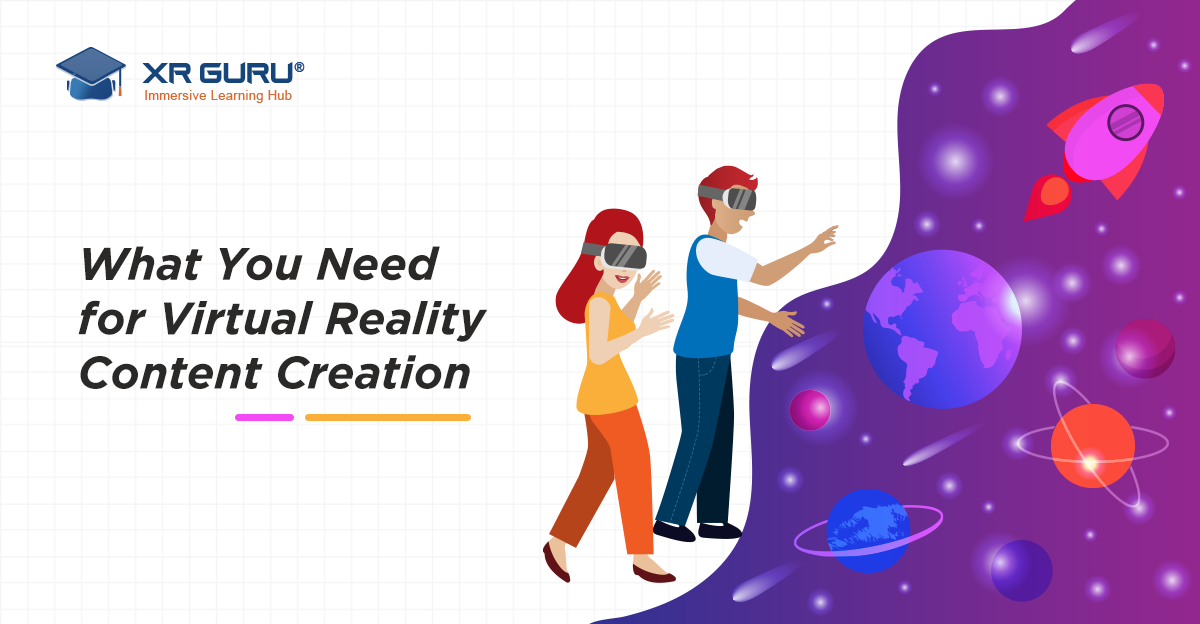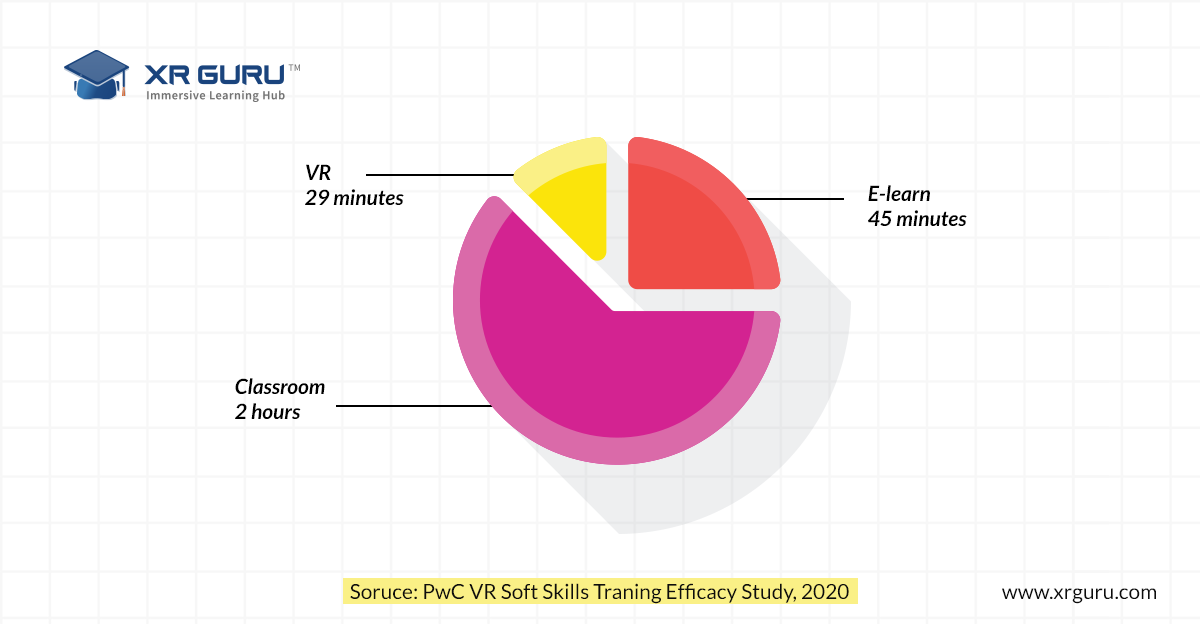What You Need for Virtual Reality Content Creation

In the modern era, where the attention span of young people is diminishing with each passing day, educators are constantly looking for methods to improve the learning/training experience. Educators often wonder, "How do you improve student engagement?" "How do you get people excited about learning/training?" One of the more effective methods to drive student engagement is using virtual reality in education. An eMarketer's report predicts that 57.1 million people in the US will use VR at least once per month in 2021. These numbers suggest that VR is becoming more popular in the education market, and more educators are starting to use VR content in classrooms as the immersive nature of virtual reality makes learning fun and engaging.
The steady growth of virtual reality in the education market has left many educators wondering how to develop VR content and create VR simulations. Creating immersive VR content is simpler than people think; there are more quality open-source libraries available today; they can help people create VR content quickly with no coding experience.
Are you interested in adopting virtual reality in learning? Do you want to learn how to create immersive VR simulations?
On July 18, 01:30 p.m. EST, XR Guru is conducting a webinar on "Building Simulations in Virtual Reality." This webinar will discuss the steps in creating an engaging VR simulation and how it can improve the learning experience.
Join our webinar for valuable insights on developing virtual reality learning content.
Here is an Overview of Our Blog:
-
1. What is Virtual Reality?
-
2. Can Your Institution Afford to Incorporate VR Content?
-
3. Hardware Required to Set Up VR Content
-
4. Technical Requirements for Creating VR Content
-
4.1. Platforms and Software Development Kits (SDK)
-
4.2. Game Engines
-
4.3. Content Creation
-
5. Why Should You Consider Investing in VR Content
-
6. VR is the Way Forward for a Better Learning Experience!
1. What is Virtual Reality?
Virtual reality (VR) is a technology that creates a computer-generated immersive environment and generates realistic images, sounds, and other sensations that simulate a user's physical presence in a virtual environment. In simpler terms, you can think of VR as a technology that tricks your brain into believing you are somewhere you are physically not present.
2. Can Your Institution Afford to Incorporate VR Content?
Before learning how to create immersive VR content, you must ask yourself whether you can afford to adopt VR learning content and what kind of Return on Investment (ROI) you can expect from this investment. The VR content creation and hardware costs can vary considerably depending on the type of VR equipment you buy, and the quality of VR experience you aspire to produce.
3. Hardware Required to Set Up VR Content
If you are thinking about developing VR content for your learning programs, you should decide the kind of hardware required to run the VR application. There are different types of VR hardware available in the market, and some of them are as follows:
- Console
- Light Mobile VR Headsets
- Premium Mobile VR Headsets
- VR Headsets Connecting to External PCs
- Standalone Headsets
- VR Haptic Feedback Suits
When it comes to VR headsets, there are several great options, but the cost of VR hardware depends on whether you want to go for high-end or low-end equipment. Some popular choices are Meta Quest 2 ($299 per headset) and Microsoft's HoloLens 2 ($3,500 - $5,199 per headset). You can explore different alternatives available in the market and choose the device that suits your budget and requirements.
4. Technical Requirements for Creating VR Content
Now that you have a basic idea of virtual reality technology, let us delve deep into how you can create VR content.
4.1. Platforms and Software Development Kits (SDK)
Developing the best VR applications begins with choosing a suitable platform and SDK. A Software Development Kit (SDK) includes software tools and programs for specific platforms. These may include libraries, samples, processes, guides, tutorials, blueprints, and more.
The VR SDK you choose for the VR software development process determines the hardware devices your users will need. It is important to research and get an expert opinion before deciding on the SDK. Some of the popular SDKs for VR software development include:
- HTC Vive
- Oculus
- Sony PlayStation
- Cross-Platform SDKs
HTC Vive:
OpenVR SDK supports HTC Vive and other VR headset-related devices. SteamVR SDK and Virtual Reality Tool Kit (VRTK) are other SDKs used for HTC Vive.
Sony PlayStation:
To develop VR content for Sony PlayStation, you require PSVR Dev Kit and become a registered developer. Features of this kit include 360-degree vision, high-quality visuals/audio, and tracking.
Oculus:
Oculus SDK is one of the most popular SDKs to develop content for Oculus Rift and Oculus Quest. The Oculus SDK comes with audio packages, assets, and more. The Oculus Mobile SDK includes libraries, tools, and resources for developing Android applications for Oculus Quest, Oculus Quest 2, and Oculus Go standalone devices.
Cross-Platform SDKs:
Google VR SDK offers a wide range of resources and development tools that you can use to create VR experiences on Google Cardboard or Daydream. Another cross-platform SDK is Amazon Sumerian which works well with popular platforms like Oculus, HTC Vive, and Lenovo Mirage. These SDKs are also compatible with Android and iOS mobile devices.
4.2. Game Engines
Game Engines are a crucial component of VR software development, as Game and VR Engines store the data that users see. Game Engines help developers build lifelike graphics and experiences.
Some popular Game Engines are as follows:
Unreal Engine:
Unreal Engine offers developers a powerful set of virtual reality software development tools. Unreal Engine allows creators across multiple industries to create stunning real-time content and VR experiences. Unreal Engine offers out-of-the-box support for all Head-Mounted Devices (HMDs).
Unity:
Unity is a popular platform for game development and real-time content creation. Unity is being widely used across different industries because it works well with 25+ well-known VR platforms. Unity offers an effective 3D editor, collaboration features, built-in designer tools, and support for CAD tools.
Lumberyard:
Lumberyard is a relatively new open-source Game Engine offered by Amazon. The Lumberyard engine integrates the use of Oculus, HTC Vive, and Open Source Virtual Reality (OSVR).
CRYENGINE:
CRYENGINE is popular among game developers and a potent virtual reality software development tool. It works well with a wide variety of platforms. CRYENGINE offers some exciting features such as built-in audio solutions, powerful visuals, sandbox tools, etc.
4.3. Content Creation
While developing VR content, 3D modeling and rendering software is vital for visualization and interactive content creation. Developers can use tools like 3ds Max and Maya to create 3D animations, textures, and effects. With Maya, developers can also create motion graphics and use them for 3D rendering, 3D visual/data modeling, and 3D shading.
5. Why Should You Consider Investing in VR Content
While most people think that VR content creation is a complex process and the costs associated with adopting VR content in education can be expensive, the advantages of VR-based learning easily justify the investment. Here are some benefits of incorporating virtual reality content in education:
-> Heightens Student Engagement:
One of the major challenges for modern-age teachers is making the lessons engaging and keeping students engaged throughout the lecture. Adopting VR in learning helps educators enhance student engagement levels. Interactive 3D models and immersive simulations can significantly increase engagement levels.
-> Multi-sensory Experience:
Virtual reality learning helps teachers create immersive simulations for students to participate in a multi-sensory learning experience.
-> Transform Teaching:
It is challenging for teachers to teach complex science topics in a traditional classroom setup. Adopting VR in learning can help instructors teach complex concepts with greater ease through interactive visuals.
-> Better Retention Rates:
Virtual reality in education helps students understand concepts better, faster, and retain information for a longer time to achieve better grades. In fact, stats show that students learning through VR learn information 4 times faster than students in a classroom.

(Source)
-> Gamified Learning:
Gamified learning with VR motivates learners and makes the learning experience fun, interactive, and appealing.
-> Distraction-free Education:
Since VR learning makes education immersive, it shuts out distractions which helps students conceptualize and understand better.
6. VR is the Way Forward for a Better Learning Experience!
Virtual reality is one of the most exciting and innovative technologies with the potential to transform how we teach, learn, and interact with learners. But like any new technology, VR has some challenges. Content creation costs and health concerns are barriers to adopting virtual reality in learning. However, with recent technological advancements, the cost of VR hardware and software is becoming more affordable, and soon we will see widespread adoption of VR in education/training. So, if you are willing to invest in VR, the possibilities could be endless, as VR could be the next big thing in the knowledge transfer and learning process.
Takeaway Thoughts
Do you want to create immersive VR learning content but do not know how to code? Do not worry. Use XR Guru Design Studio to create, distribute, and monetize engaging VR content with no coding experience! Access an expansive library of 3D models or import your own to enhance your VR content. You create the content, and we will help promote it to the right target audience. Contact us for all your virtual reality learning needs.
Join Us for Our Next Webinar
Title: Building Simulations in Virtual Reality
Learn how to create virtual reality simulations/content and how adopting VR in education can transform the learning experience. Join our live webinar to learn more about exploring careers with virtual reality.
If you cannot attend, register anyway, and we will send you the recording.
Host: Doug Smith
When and Where:
01:30 p.m. EST, Tuesday, July 18, 2022
25 Minutes
Zoom Link for Registration
Goal: To help educators understand how to create virtual reality content/ immersive simulations and the advantages of using VR in learning.
Who Should Join:
- Subject Matter Experts
- Content Creators
- Educators
- Administrators and
- Those aspiring to adopt VR in classrooms.
Highlights of the Webinar:
- Learn how to create VR content and build VR simulations
- Learn how adopting virtual reality content can help students
- Learn the benefits of incorporating VR in classrooms
- View samples of immersive content
- Learn how to access our free Authoring Tool
- View samples of content you can create in our Authoring Tool
Outcome: Attending this webinar can help you understand the various steps involved in creating virtual reality content and how it can enhance teaching/learning methods.



Comments
Post a Comment